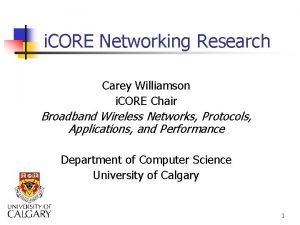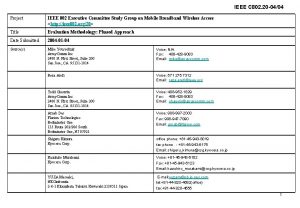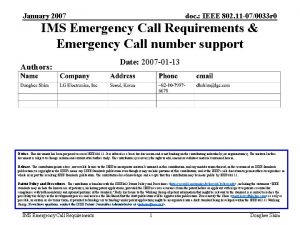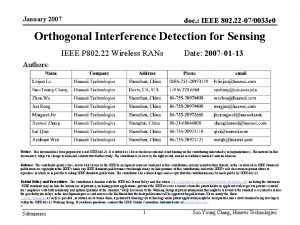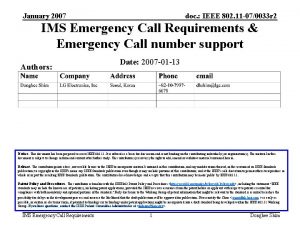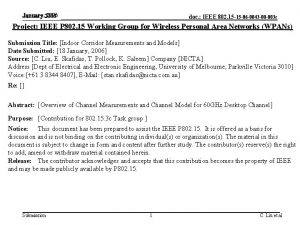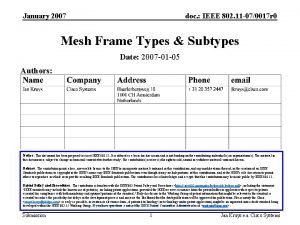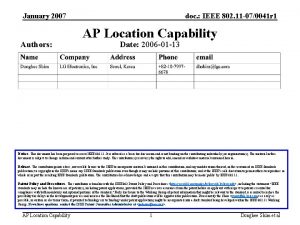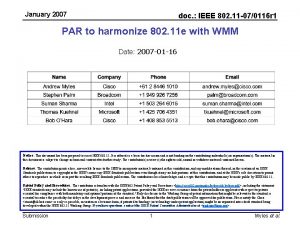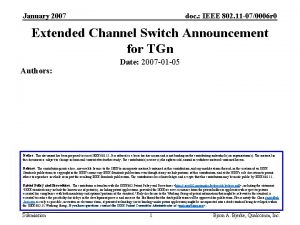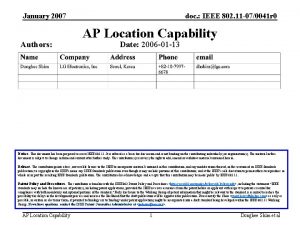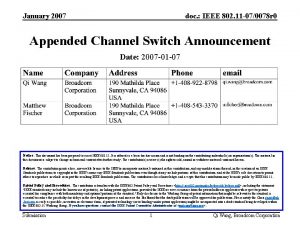January 2007 doc IEEE 802 22 070033 r













- Slides: 13

January 2007 doc. : IEEE 802. 22 -07/0033 r 0 Orthogonal Interference Detection for Sensing IEEE P 802. 22 Wireless RANs Date: 2007 -01 -13 Authors: Notice: This document has been prepared to assist IEEE 802. 22. It is offered as a basis for discussion and is not binding on the contributing individual(s) or organization(s). The material in this document is subject to change in form and content after further study. The contributor(s) reserve(s) the right to add, amend or withdraw material contained herein. Release: The contributor grants a free, irrevocable license to the IEEE to incorporate material contained in this contribution, and any modifications thereof, in the creation of an IEEE Standards publication; to copyright in the IEEE’s name any IEEE Standards publication even though it may include portions of this contribution; and at the IEEE’s sole discretion to permit others to reproduce in whole or in part the resulting IEEE Standards publication. The contributor also acknowledges and accepts that this contribution may be made public by IEEE 802. 22. Patent Policy and Procedures: The contributor is familiar with the IEEE 802 Patent Policy and Procedures http: //standards. ieee. org/guides/bylaws/sb-bylaws. pdf including the statement "IEEE standards may include the known use of patent(s), including patent applications, provided the IEEE receives assurance from the patent holder or applicant with respect to patents essential for compliance with both mandatory and optional portions of the standard. " Early disclosure to the Working Group of patent information that might be relevant to the standard is essential to reduce the possibility for delays in the development process and increase the likelihood that the draft publication will be approved for publication. Please notify the Chair Carl R. Stevenson as early as possible, in written or electronic form, if patented technology (or technology under patent application) might be incorporated into a draft standard being developed within the IEEE 802. 22 Working Group. If you have questions, contact the IEEE Patent Committee Administrator at patcom@iee. org. > Submission 1 Soo-Young Chang, Huawei Technologies

January 2007 doc. : IEEE 802. 22 -07/0033 r 0 Orthogonal Interference Detection Incumbent signal selection without service interruption can be achieved. Submission 2 Soo-Young Chang, Huawei Technologies

January 2007 doc. : IEEE 802. 22 -07/0033 r 0 Introduction (1/2) • If interference (or an incumbent user signal) exists in the frequency domain of the received signals, • Otherwise, Xk, i is the symbol transmitted at time i for the kth subcarrier; Hk, i is the channel response at time i for the kth subcarrier; Yk, i is the received symbol at time i for the kth subcarrier; Ik, i is the interference signal at time i for the kth subcarrier. Submission 3 Soo-Young Chang, Huawei Technologies

January 2007 doc. : IEEE 802. 22 -07/0033 r 0 Introduction (2/2) • Assume in coherence time and coherence bandwidth, Hk, i is constant. • Assume (Qk, i, Qk, i+1) is orthogonal to transmitted data (Xk, i, Xk, i+1). • A group of received data (Yk, i, Yk, i+1 ) are correlated with orthogonal signal (Qk, i, Qk, i+1). If interference exists: else: • Determine whether interference exists using energy detection: If , interference exists, otherwise, interference does not exist. T (Xk, i, Xk, i+1): interference detection threshold Submission 4 Soo-Young Chang, Huawei Technologies

January 2007 doc. : IEEE 802. 22 -07/0033 r 0 Orthogonal Interference Detection for Multiple Symbols • Use multi groups of received data to increase reliability of the detection. • Using data of N different time slots to form N-1 groups of signal vectors, when , interference exists. • Using data of N different sub-carriers to form N-1 groups of signal vectors, when Submission , interference exists. 5 Soo-Young Chang, Huawei Technologies

January 2007 doc. : IEEE 802. 22 -07/0033 r 0 Orthogonal Interference Detection Using Pilots • The location of a pilot is known a priori. • When Xk, i of a pilot is always “ 1” , the equation for the judgement is • When Xk, i of a pilot is alternatingly “ 1” or “-1” , the equation for the judgement is Submission 6 Soo-Young Chang, Huawei Technologies

January 2007 doc. : IEEE 802. 22 -07/0033 r 0 Orthogonal Interference Detection Using Traffic Data • Traffic data are richer than pilots for interference detection. • Received symbols Yk, i are buffered. • Coding and modulation are performed to get Xk, i. – If correct in decoding , then detect interference based on the algorithm mentioned in the previous slide. – If erroneous in decoding , then calculate PER (Packet Error Rate) : If PER>threshold, BS will schedule quiet periods. Submission Interference Detection at receiver 7 Soo-Young Chang, Huawei Technologies

January 2007 doc. : IEEE 802. 22 -07/0033 r 0 Simulation (1/5) Detection probabilities under INR=30 d. B of the algorithm. The upper figure illustrates the detection with one group of symbols while the bottom one illustrates the detection with average of 8 groups of symbols. Submission 8 Soo-Young Chang, Huawei Technologies

January 2007 doc. : IEEE 802. 22 -07/0033 r 0 Simulation (2/5) Detection probabilities under INR=20 d. B of the algorithm. The upper figure illustrates the detection with one group of symbols while the bottom one illustrates the detection with average of 8 groups of symbols. Submission 9 Soo-Young Chang, Huawei Technologies

January 2007 doc. : IEEE 802. 22 -07/0033 r 0 Simulation (3/5) Detection probabilities under INR=0 d. B of the algorithm. The upper figure illustrates the detection with one group of symbols while the bottom one illustrates the detection with average of 8 groups of symbols. Submission 10 Soo-Young Chang, Huawei Technologies

January 2007 doc. : IEEE 802. 22 -07/0033 r 0 Simulation (4/5) Detection probabilities under SNR=10 d. B of the algorithm. The left and right figures illustrate the detection with one group of 24× 2546 samples from two different DTV signal files, WAS_311_36_06052000_ref and WAS_311_48_06052000_ref respectively. Submission 11 Soo-Young Chang, Huawei Technologies

January 2007 doc. : IEEE 802. 22 -07/0033 r 0 Simulation (5/5) • More simulation results by different DTV signal files are in the document. Submission 12 Soo-Young Chang, Huawei Technologies

January 2007 doc. : IEEE 802. 22 -07/0033 r 0 Conclusions • Interference detection can be done without channel estimation. • Interference detection can be done without service interruption. • Multiple groups of received data can be used to increase detection reliability. • Interference detection can be done using traffic data by performing decoding and demodulation at the receiver. Submission 13 Soo-Young Chang, Huawei Technologies












